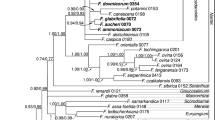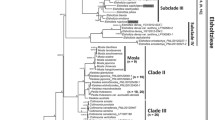Abstract
Phylogenetic relationships within the genus Pieris (Ericaceae) were investigated based on the rbcL and matK genes along with five spacer sequences of chloroplast DNA to address questions regarding the phylogeography of the genus in association with insular plants on the Ryukyu Islands. The most parsimonious trees indicated that P. floribunda from eastern North America is a sister taxon to the remaining taxa examined, and suggested that the East Asian taxa examined are monophyletic. A morphologically cohesive group, section Pieris, was revealed to be paraphyletic. Within the East Asian clade, insular endemics from the Ryukyu Islands, Taiwan, and mainland Japan formed a sister group to P. formosa from the Himalayas and southern China. Our data suggest that the insular endemics of the Ryukyu Islands and Taiwan arose via allopatric divergence as a result of a paleogeographical land configuration of a landbridge during the early–middle Pleistocene in the Quaternary Period.
Similar content being viewed by others
References
Association for Geological Collaboration of Japan (1965) The geologic development of the Japanese Islands. Tsukiji Shokan, Tokyo
Bremer K (1988) The limits of amino acid sequence data in angiosperm phylogenetic reconstruction. Evolution 42: 795–803
Bremer K (1994) Asteraceae: cladistics and classification. Timber Press, Portland
Chiang TY, Chiang YC, Chen YJ, Chou CH, Havanond S, Hong TN (2001) Phylogeography of Kandelia candel in east Asiatic mangroves based on nucleotide variation of chloroplast and mitochondrial DNAs. Mol Ecol 10:2697–2710
Demesure B, Sodzi N, Petit RJ (1995) A set of universal primers for amplification of polymorphic non-coding regions of mitochondrial and chloroplast DNA in plants. Mol Ecol 4:129–131
Dohzono I, Suzuki K (2002) Bumblebee-pollination and temporal change of the calyx tube length in Clematis stans (Ranunculaceae). J Plant Res 115: 355–359
Dohzono I, Suzuki K, Murata J (2004) Temporal changes in calyx tube length of Clematis stans (Ranunculaceae): a strategy for pollination by two bumblebee species with different proboscis lengths. Am J Bot 91: 2051–2059
Doyle JJ, Doyle JL (1987) A rapid DNA isolation procedure for small quantities of fresh tissue. Phytochem Bull 19: 11–15
Environmental Agency of Japan (2000) Threatened wildlife of Japan, Red Data Book, 2nd edn., vol 8 (Vascular Plants). Japan Wildlife Research Center, Tokyo (in Japanese)
Felsenstein J (1985) Confidence limits on phylogenies: an approach using the bootstrap. Evolution 39: 783–791
Hamilton MB (1998) Four primer pairs for the amplification of chloroplast intergenic regions with intraspecific variation. Mol Ecol 8: 513–525
Hatsushima S (1969) Species of Pieris from Japan and Taiwan. J Geobot 17: 75–76 (in Japanese)
Hayata B (1911) Materials for a flora of Formosa. J Coll Sci Imp Univ Tokyo 30: 169
Hayata B (1912) Pieris taiwanensis. Plate 14 in Ic. Plant. Formosanarum. Vol 2. reprint Governmental Printers, Taipei
Hiramatsu M, Li K, Okubo H, Huang K L, Huang C W (2001) Biogeography and origin of Liliumu longiflorum and L. formosanum (Liliaceae) endemic to the Ryukyu Archipelago and Taiwan as determined by allozyme diversity. Am J Bot 88: 1230–1239
Inouye DW (1978) Resource partitioning in bumblebees: experimental studies of foraging behavior. Ecology 59: 672–678
Inouye DW (1980) The effect of proboscis and corolla tube lengths on patterns and rates of flower visitation by bumblebees. Oecologia (Berl.) 45: 197–201
Inoue K, Amano M (1986) Evolution of Campanula punctata Lam. in the Izu Islands change of pollinators and evolution of breeding systems. Plant Spec Biol 1: 89–97
Judd WS (1982) A taxonomic revision of Pieris (Ericaceae). J Arnold Arbor 63: 103–144
Kato M (2000) Anthophilous insect community and plant-pollinator interactions on Amami Islands in the Ryukyu Archipelago, Japan. Contr Boil Lab Kyoto Univ 29: 157–252
Kimura M (1996) Paleogeography of the Ryukyu Arc. Chikyu Monthly 18: 488–494 (in Japanese)
Kimura M (2000) Paleogeography of the Ryukyu Islands. Tropics 10: 5–24
Kitamura S, Murata G (1972) New names and new combinations adopted in our colored illustrations of woody plants of Japan I. Acta Phytotax Geobot 25: 33–44 (in Japanese)
Kizaki K, Oshiro I (1977) Paleogeography of the Ryukyu Islands. Marine Sci Monthly 9: 543–549 (in Japanese with English abstract)
Kizaki K, Oshiro I (1980) The origin of the Ryukyu Islands. In: Kizaki K (ed) Natural history of the Ryukyus. Tsukiji-shokan, Tokyo, pp 135–150 (in Japanese)
Kron K A, Judd W S, Crayn D M (1999) Phylogenetic analyses of Andromedeae (Ericaceae subfam. Vaccinioideae). Am J Bot 86: 1290–1300
Kron K A, Judd W S, Stevens P F, Crayn D M, Anderberg A A, Gardek P A, Quinn C J, Luteyn J L (2002) Phylogenetic classification of Ericaceae: molecular and morphological evidence. Bot Rev 68: 335–423
Li HL, Lu SY, Yang YP, Tseng YH (1998) Ericaceae. In: Editorial Committee of the Flora of Taiwan, Department of Botany, National Taiwan University (ed) Flora of Taiwan second ed. vol 4. National Taiwan University, Taipei, pp 17–39
Mabberley DJ (1997) The plant book. A portable dictionary of the higher plants, 2nd ed. Cambridge University Press, Cambridge
Makino T (1961) Makino’s new illustrated flora of Japan. Hokuryukan Co., Tokyo
Masamune G (1955) Enumeratio tracheophytarum Ryukyu Insularum (VI). Sci Rep Kanazawa Univ 3: 253–338
Miikeda O, Yukawa T (2001) A simple procedure of DNA purification by gel filtration chromatography. Bunrui 1: 79–82 (in Japanese)
Nei M (1987) Molecular evolutionary genetics. Columbia University Press, New York
Niihara S (2000) Living collection of woody plants endemic to Kagoshima Prefecture, southern Japan I. Bull Kagoshima Pref For Exp Stn 5: 19–31 (in Japanese with English summary)
Ohwi J (1930) Symbolae ad Floram Asiae Orientalis. Bot Mag Tokyo 44: 564–573
Ohwi J (1965) Flora of Japan. Smithsonian Inst Press, Washington, D.C. p 1067
Sakagami FS, Ishikawa R (1969) Note préliminaire sur la répartiton géographique des Bourdons japonais, avec descriptions et remarques sur Quelques fornes Nouvelles ou peu Connues. Jour Fac Sci Hokkaido Univ Ser VI, Zool 17: 152–191
Setoguchi H, Ohba H (1995) Phylogenetic relationships in Crossostylis inferred from restriction site variation of chloroplast DNA. J Plant Res 108: 87–92
Setoguchi H, Watanabe I (2000) Intersectional gene flow between insular endemics of Ilex (Aquifoliaceae) on the Bonin Islands and the Ryukyu Islands. Am J Bot 87: 793–810
Setoguchi H, Fujita T, Kurata K, Maeda Y, Peng C I (2006) Comparison of leaf and floral morphology among insular endemics of Pieris (Ericaceae) on the Ryukyu Islands and Taiwan. Acta Phytotax Geobot 57: 173–182
Small J K (1914) Ericaceae. N Amer Fl 29: 33–102
Suzuki K (1992) Bumblebee pollinators and pollination ecotypes of Isodon umbrosus and I. shikokianus (Lamiaceae). Plant Spec Biol 7: 37–48
Swofford DL (2002) PAUP*: phylogenetic analysis using parsimony (*and other methods), version 4.0b10 Sinauer, Sunderland, Mass
Taberlet P, Gielly L, Pautou G, Bouvet J (1991) Universal primers for amplification of three non-coding regions of chloroplast DNA. Plant Mol Biol 17: 1105–1109
Ujiie H, Saito Y (1974) History of Cenozoic of the Ryukyu Islands in relation to biogeography. Nat Sci Mus 41: 131–139 (in Japanese)
Ujiie H (1996) Geological history of the Ryukyu Island Arc. In: Pages Ujiie H (ed) Nature of Okinawa; Geomorphology and geology. Hirugisha, Naha (in Japanese), pp. 251–255
Van Steenis CGGJ (1981) Rheophytes of the world. Sijthoff and Noordhoff, Alphen aan den Rijin
Walker EH (1976) Pieris. In: Walker EH (ed) Flora of Okinawa and the Southern Ryukyu Islands. Smithsonian Inst Press, Washington, D.C. pp 803–804
Yamazaki T (1989) Ericaceae. In: Satake Y, Hara H, Watari S, Tominari T (eds) Wild flowers of Japan, woody plants, vol 2. Heibonsha Ltd. Publishers, Tokyo, pp 122–156
Yamazaki T (1993) Ericaceae. In: Iwatsuki K, Yamazaki T, Boufford D, Ohba H (eds) Flora of Japan. Kodansha Ltd. Publishers, Tokyo, pp 6–63
Yokoyama J, Suzuki M, Iwatsuki K, Hasebe M (2000) Molecular phylogeny of Coriaria, with special emphasis on the disjunct distribution. Mol Phylogenet Evol 14: 11–19
Author information
Authors and Affiliations
Corresponding author
Rights and permissions
About this article
Cite this article
Setoguchi, H., Watanabe, W., Maeda, Y. et al. Molecular phylogeny of the genus Pieris (Ericaceae) with special reference to phylogenetic relationships of insular plants on the Ryukyu Islands. Plant Syst Evol 270, 217–230 (2008). https://doi.org/10.1007/s00606-007-0600-8
Received:
Accepted:
Published:
Issue Date:
DOI: https://doi.org/10.1007/s00606-007-0600-8




